Views: 57
前幾年參加一個 Piedmont 酒宴,看到坐在我對面的仁兄總愛把酒先嗅一嗅,想一想,然後很認真的吐出 traditional 或 modern 一詞。整個晚上,他就是這樣多次穿越了傳統與現代。我是初哥,只覺得在我面前的是一座座高不可攀的大山,而對面的高手卻見山不是山,見水不是水。那是我頭一回領教 Piedmont 這座巍峨的殿堂。
究竟傳統好還是現代好?
以前唸社會學,這可算是最最重要的一個課題。想不到喝酒也會喝出那麼嚴肅的話題。但對 Nebbiolo 痴,這卻是永遠談不完的話題,雖然永遠談不出大家都能接受的答案。
有人說現代派的酒較宜早飲用,但所謂現代派的釀酒法,不過是 Bordeaux 傳統的意大利翻版。我看 Lafite 不見得可以早喝吧?
又有人說現代派的酒不能陳年,這問題倒是非同小可的。Barolo 從來以長壽出名,一般講法是不夠十年的酒是不能喝的。但要證實這觀點也不容易,因為所謂現代派的酒,主要還是八十年才代才開始大量出現,陳年的酒根本就不多。
帶著這一大串問題,我決定花一個多月的時間來走訪十六位年齡從 19 到 35 歲的 Barolo 與 Barbaresco 證人,當中既有傳統派也有現代派的,且聽他們怎麼說。
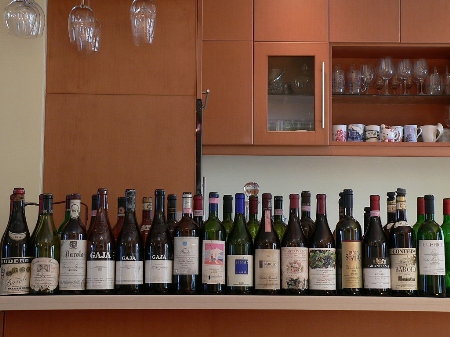

長者所言
我們先從最年長的四位開始,在他們那年代,傳統與現代的爭論還沒有展開。
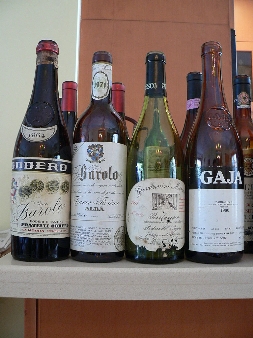
兩位 Barolo 像先生,而 Barbaresco 則像小姐。
1964 Oddero Barolo 有些霉味,像樹林裏濕泥土的氣味,入口有點像espresso。1971 Franco Fiorina Barolo Riserva 精彩得多,顏色仍然頗深,複雜的果味與細滑的丹寧令我覺得酒還未走到盡頭。很大的驚喜!
其實憑那陣揮之不去的霉味,我估計 Oddero 可能保存得不太理想。我翻查資料,發現 Burgundy 名寫手 Pierre Rovani 在 2006 年曾在餐廳開過這瓶酒,他大讚酒的香氣像 1959 年的 Chambertin ,味道則是頂級 Burgundy 與 Hermitage 的混合體!有機會一定要找一瓶 1964 Oddero 再試試。
最令我難忘的還是這瓶 1971 Giovannini-Moresco Enrico Barbaresco Podere del Pajore 。紅寶石的通透顏色,纖柔的酒體,我沐浴在她最後的餘暉。這是典型的成熟 Barbaresco 嗎?
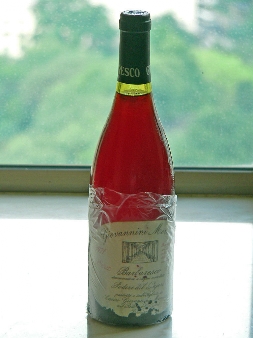
1980 Gaja Barbaresco 味如淡淡的葡萄汁,這是 Angelo Gaja 用現代手法釀造的第二個年份,但由于 1980 是比較差的年份,所以作不了準。
這幾瓶成熟的 Barolo 與 Barbaresco 都有一種很鄉土味的優雅。這便是傳統的風味嗎?

中年的 Barolo 與Barbaresco 又如何?這裏的 12 瓶當中, ’88 與 ’90 年大概各佔一半。一般意見是﹕90 年是上佳年份,而 88 則稍次。 Barolo 有點像 Burgundy ,講究什麼葡萄園出什麼風味的酒,所以我會從 Barolo 村開始,以順時針方向拜訪五大村。
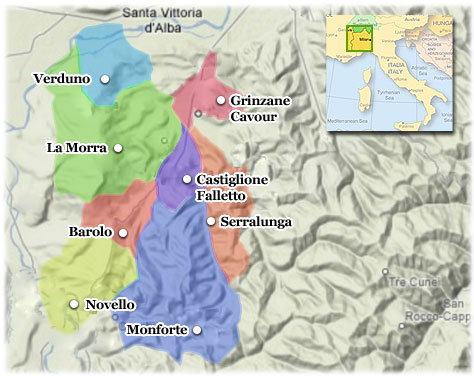
Barolo 村
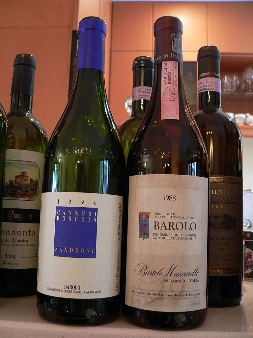
Bartolo Mascarello 是眾所公認的傳統大師,而 Luciano Sandrone 這位新紮師兄則一般歸類為現代派。
1988 Bartolo Mascarello 與 1990 Luciano Sandrone Cannubi Boschis 都是上品。我感受到的,同樣是一種很開闊的氣象。
Bartolo 酒身輕,我好像透過輕紗感受到香與味的不斷變化,得到的是一種飄逸的享受。這是一種道家的味道,像宋人山水那樣把天、地、人收進 750ml 的瓶子裏。
Luciano 的酒身同樣是偏向輕柔的,場景同樣是宏大的,我跟著他在大地上採拾鮮果。大地是飽滿的,所以我得到的也是飽滿的。
Bartolo 是 Mahler;Luciano 是 Dvorak!
傳統與現代,不過是對大自然的不同演繹?

La Morra 村
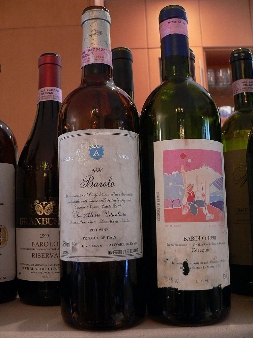
如果Bartolo Mascarello 是傳統派旗手,那麼 Elio Altare 應該是現代派的祭酒。他的 1990 Arborina 最突出之處是嬌艷的果味,純之又純,幾乎是一種 monochromatic 的風格,顏色只有一種﹕fruit!
Roberto Voerzio 同樣是現代派的急先鋒,但這次的 1990 Cerequio 有小許霉味,果味如 espresso 的漆黑,如果用今年初喝過的 1989 Cerequio 來作準,記憶中同樣是果味豐盈,但酒體較Altare 厚重。我想這一瓶 1990 可能保存得不太好。
奇怪的是,La Morra 主要的酒庄好像都是現代派的(Marcarini 是例外),或許現代派的處理手法比較能突出 La Morra 特別具有的芳香和果味?

Castiglione Falletto 村
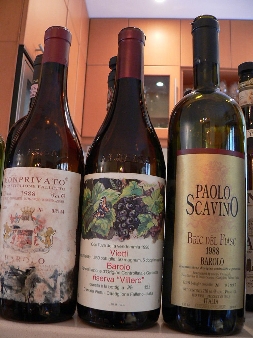
Paolo Scavino 是現代派(雖然他 1993 年才開始全面改用小木桶),而 Giuseppe Mascarello 與 Vietti 都是很有地位的傳統派。三瓶酒都非常好喝,也同時表現出 Castiglione Falletto 的特性﹕兼取 La Morra 的果味與 Serralunga 的結構。
要我選最好的一瓶,我會選 Scavino 的 ’88 Bric del Fiasc !以前喝過 1997 ,要與丹寧博鬥,但這瓶 1988 幾乎熟透了,是一種萬化俱寂的境界。但 Mascarello 偏向輕柔通透,Vietti 偏向豐厚,同樣是上品。
Castiglione Falletto 是否像儒家的「中庸」,對傳統與現代也兼收並蓄?或者說像 Mozart ?

Serralunga d’Alba 村
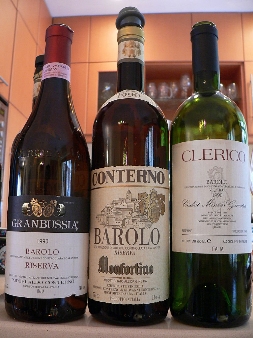
Giacomo Conterno 是傳統派的大天王,他的 1990 Monfortino 要 10 小時原瓶透氣,然後再換瓶一兩個小時,酒的勁力才開始出來,期間一直不停變化,蔚為奇觀!酒的丹寧仍然很多,看來這瓶酒頂多像個十來歲的小伙子!
其實 Cascina Francia 位于 Serralunga 西面的山坡,面對 Monforte ,所以我大膽猜測他的酒靠近 Monforte 的硬朗風格多于 Serralunga 的剛柔並濟特色。這種硬朗的特性是否用傳統手法演繹特別適宜?

Monforte d’Alba 村
Domenico Clerico 是十足的現代派,正如 Aldo Conterno 是傳統派。但 Clerico Ginestra 堅硬無比,如果1990 Monfortino 是小伙子,則 1990 Ginestra 只是個小孩!奇怪的是,兩年前我也喝過一瓶,當時覺得相當可口,但這次卻發現酒很緊閉。是酒的變化還是 bottle variation 的問題,要以後再求證了。
Aldo Conterno 的 1990 Granbussia 已屆成熟,有鮮甜的果味、幼滑的丹寧,優雅兼複雜。我總覺得他欠缺了Monforte 的典型硬朗風格(完全沒有 Monfortino 或 Ginestra 的影子),反而有幾分像 Bartolo Mascarello !翻開地圖一看,原來 Aldo Conterno 所在的 Bussia 非常靠近 Barolo 村!

Barbaresco
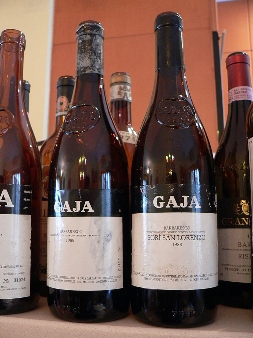
Sheldon Wasserman 認為小木桶對酒的壞處多于好處,但他還是推許 Angela Gaja 是用小木桶最成功的一位。他說﹕
“ … the wine takes on a certain subtlety and suppleness without losing the personality of the nebbiolo grape.” (Italy’s Noble Red Wines, p.95)
憑 Gaja 的 1988 年 Barbaresco 與單一葡萄園的 San Lorenzo ,我覺得他的立論是公正的。
兩瓶酒都很有活力,酸度與丹寧仍然活躍。基本 Barbaresco 選自 14 個葡萄園,有較粗豪的性格,San Lorenzo 則平衡典雅,輕輕的松香味很誘人。

究竟傳統好還是現代好?
匆匆走過 Piedmont 一遍以後,我初步認為最好不要把問題絕對化。
用古典音樂打比喻,Piedmont 的不同風土(terroir)自有不同的風味,好比不同的作曲家。釀酒的人好比樂團指揮或演奏者,他的任務是演繹他心中的作品。貝多芬交響樂的兩大指揮家 Toscanini 與 Furtwangler 同為世人稱頌,但他們一個強調忠于原譜,一個表現樂曲的精神面,很難說他們有高下之分。
繼續用這個音樂的比喻,我覺得 Barolo 像 Dvorak 與 Mahler ,La Morra 像 Chopin 與 Debussy ,Castiglione Falletto 像 Mozart ,Serralunga d’Alba 像 Brahms ,Monforte 則像 Beethoven 。
還有,偉大的作曲家,也不是每首作品都是佳作,就如年份有好壞一樣。
我還有個猜想﹕Serralunga d’Alba 與Monforte 較適宜傳統派的演繹,La Morra 較適宜現代派,至于其他的村,我覺得傳統與現代各有千秋。

在結束以前,我想錄下兩位高人的高論,以供參照。
Sheldon Wasserman 說﹕
“The basic styles can be defined, but there are still many variations and differences within the categories, as well as many gradations in between. We are dealing with individuals here — hard-headed farmers, college-trained technicians, market-sensitive businessmen, and, in some cases, artists.
Even in the past, when less options were open to them and winemakers learned from their fathers and uncles, styles of wines varied, not only from one vineyard area to another but also from cousin to cousin and neighbor to neighbor. All had their own ways of doing things.” (Italy’s Noble Red Wines, p.15)
Antonio Galloni 最一語中的﹕
“I think it depends what you are looking for in a wine. The modernists were/are more concerned with an overt expression of fruit in the wines. They have achieved this not only through winemaking techniques, but also (and equally importantly) through lower yields and greater cleanliness in the cellar, both practices that most traditionalists have adopted to some extent. To offer a contrast, I remember Beppe Rinaldi telling me a few years ago “I hate fruit!” Clearly he is trying to make wines that capture more of the tertiary nuances of Nebbiolo.
A recent tasting of the 1982 Barolos from Elio Altare and Bartolo Mascarello bore this out. The Altare had more fruit and was much fresher, while the Bartolo was a more mid-weight wine with greater tertiary nuances and fully developed aromatics. Both were wonderful. Early wines from producers such as Clerico and Sandrone suggest that they will age with more fruit and stuffing, but may never develop the full range of tertiary aromas and nuances one is likely to find in more traditionally made wines. Sandrone’s 1982 Barolo may be the exception to that.” (From a discussion thread entitled Will a modernist Barolo ever develop the complexity of a 61 Monfortino? Found in “In the Cellar Forum” on erobertparker.com)
究竟傳統好還是現代好?
你說呢?
Thanks for sharing! Will spent some time going through it,wow! Is it difficult to find old vintage italian wines in Hong Kong?
I have only tried a 85 giacomo conterno monfortino, generously shared by a good friend, so lovely.
[版主回覆07/13/2009 13:36:00]'85 Monfortino must be a real giant of a wine! I'm saving this for a real occasion!
I guess few people care for Italian fine wine in Hong Kong. Altaya Wines is a good source, and so is Italian Wine Merchants.
WOW, what a wonderful tasting, i do think you spent a lot for time to seek and prepare for those wine! Do agree with teahorse it is hard to find those old vintage in HK !
[版主回覆07/13/2009 14:01:00]I love reading books, and I borrow that method to "read" wines. There's more fun doing it this way, but yes it needs a lot more time and effort. But as people say: no pain, no gain!
Glad that you enjoy it!
drooling…..!!
so is there any similar traits on Barolo?
[版主回覆07/14/2009 22:36:00]Soulful!
這篇無得頂
[版主回覆07/15/2009 23:18:00]Glory be to Barolo! Grazie!
一篇分析得十分好的文章,再次謝謝!
自己飲葡萄酒的日子實在不短,但真正學酒只是這幾年間的事,葡萄酒的世界確實浩翰,每天都在努力學習中。幸運地在機緣巧合下結下了意大利葡萄酒緣份,有幸可以品嘗過一些經典的傳統及現代意大利珍品!
若問我傳統好還是現代好?我會答:『各有各好,真不能一蓋而論。』
簡單的感覺是:現代派給我的印象較勁、香、熱情澎湃;而傳統派較靜、柔、內斂細緻。現代派愛唱〝熱情的沙漠〞,而傳統派會低哼一首 "芳華絕代",真是各自各精彩!
喜歡現代派 ~ 愛它的激情動感;享受傳統派 ~ 留戀它的細水長流,輕柔地送上陣陣幽香及迷人的風韻,扣人心弦 ﹍ 還是喜歡傳統派!
純屬個人意見,勿見笑!
[版主回覆07/17/2009 21:28:00]講口味,我肯定偏愛傳統。但天大地大,只有一種口味,也是對天地的不敬;所以我也欣賞那種不是純粹追隨潮流(或反傳統),純為迎合市場的「新派」酒,而是多番嘗試,用另一角度讓我們領受天與地的恩賜。Angelo Gaja 正是當中的表表者。
講得玄一點,從見山是山、到見山不是山、再回到見山還是山,這才是了義。
謝謝你看得那麼細心,也回得那麼細膩。我仿佛聞到 Bartolo 了!
Do you recommend any good reading materials for italian wines?
[版主回覆07/20/2009 22:48:00]I mentioned several sources in a previous blog. Please take a look at this:
http://hk.myblog.yahoo.com/wonghouseng/article?mid=1979
If you subscribe to Robert Parker's online version erobertparker.com, there is a very informative forum called In the Cellar.
Welcome to the world of Italian wine!
我現在看你這篇blog的感覺就像你數年前看著滿桌的崇山峻嶺和對面的高手的感覺,佩服佩服
[版主回覆07/27/2009 08:14:00]歡迎加入 Piedmont 的世界!
怎么说19-35岁,1964 Oddero Barolo已经45岁的吧?
[版主回覆09/06/2013 10:14:35]喝醉了!